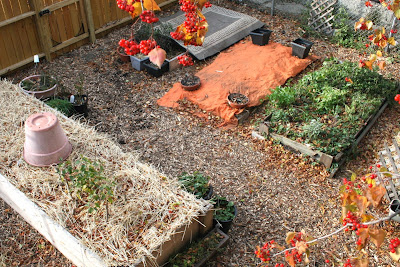Sincere apologies for the lack of gardening posts this season, but it's only because there's been so much going on outdoors that there just hasn't been any time to sit in front of the computer! Now that it's gotten a little cooler, it's time to freshen up the blog. I was recently asked to contribute something to The Brine, the official newsletter of the Dill Pickle Co-Op, and I thought I'd cross-post that article here, as it's all about how to prepare your garden for the winter. It's a short article, but it covers the basics:
It's been a wonderful gardening season, but as the saying goes, all things must pass, and it's time to put the tools away and lay the garden to rest for the winter. Proper care now will assure that all the hard work you've put into your garden this year will be preserved. Your plants are only as healthy as the soil beneath them, and protecting that living ecosystem is critical.
The most important word to remember here is mulch! Maybe you thought ahead and sowed a winter cover crop, and you have a lush green canopy of living foliage protecting your soil, but if not, there are plenty of options left to you. Fall leaves are one of the greatest materials you can add to a garden, and they're freely available this time of year. Shredded leaves are best as the increased surface area allows for optimal decomposition, insulation, and airflow. Many gardeners are fans of the "chop and drop" method of composting. Simply cut any remaining vegetable matter into 1-3" pieces and scatter that material over the top of your garden bed, or till it into the top few inches of soil. Be wary of incorporating tomato plants into the soil, though, as tomatoes are exceedingly prone to soil-borne pathogens. Collect your tomato plants and compost them away from your veggie bed. The same goes for any diseased plant material or rotting fruits that may be lying around. Remove them! You want to start out with a clean garden bed before you begin to mulch.
Ideally you'll have a layer of mulch a few inches deep over your entire garden bed -- but not directly touching any perennials which remain in your garden. Leave those for winter interest and to provide snuggly places for helpful critters like ladybugs. Don't have 2 inches of mulch yet? Sheets of cardboard or even old carpet scraps make a fine winter mulch. Remove the carpet in the spring, obviously. Straw bales are another great addition to the garden and are often available for free once "hay ride" season is over. Look around! Taking some time now to protect your soil will reap rich rewards in the spring, so get out and enjoy those last few chores in the garden before Jack Frost comes in and sets up his camp there.
Hope you enjoyed this post. Just because winter is fast approaching doesn't mean gardening season is over! Our neighbors at the Monarch Garden have several hoop houses established, and there's an outdoor worm bin at the Thomas Street Garden which I'm optimistic about keeping active. Stay tuned for more rock and roll!
